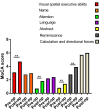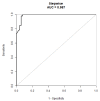Nomogram to Predict Cognitive State Improvement after Deep Brain Stimulation for Parkinson's Disease
- PMID: 35741644
- PMCID: PMC9220903
- DOI: 10.3390/brainsci12060759
Nomogram to Predict Cognitive State Improvement after Deep Brain Stimulation for Parkinson's Disease
Abstract
Purpose: Parkinson's disease (PD) is a common neurodegenerative disease, for which cognitive impairment is a non-motor symptom (NMS). Bilateral subthalamic nucleus deep brain stimulation (STN-DBS) is an effective treatment for PD. This study established a nomogram to predict cognitive improvement rate after STN-DBS in PD patients.
Methods: We retrospectively analyzed 103 PD patients who underwent STN-DBS. Patients were followed up to measure improvement in MoCA scores one year after surgery. Univariate and multivariate logistic regression analyses were used to identify factors affecting improvement in cognitive status. A nomogram was developed to predict this factor. The discrimination and fitting performance were evaluated by receiver operating characteristics (ROC) analysis, calibration diagram, and decision curve analysis (DCA).
Results: Among 103 patients, the mean improvement rate of the MoCA score was 37.3% and the median improvement rate was 27.3%, of which 64% improved cognition, 27% worsened cognition, and 8.7% remained unchanged. Logistic multivariate regression analysis showed that years of education, UPDRSIII drug use, MoCA Preop, and MMSE Preop scores were independent factors affecting the cognitive improvement rate. A nomogram model was subsequently developed. The C-index of the nomogram was 0.98 (95%CI, 0.97-1.00), and the area under the ROC was 0.98 (95%CI 0.97-1.00). The calibration plot and DCA demonstrated the goodness-of-fit between nomogram predictions and actual observations.
Conclusion: Our nomogram could effectively predict the possibility of achieving good cognitive improvement one year after STN-DBS in patients with PD. This model has value in judging the expected cognitive improvement of patients with PD undergoing STN-DBS.
Keywords: Parkinson’s disease; cognitive state; deep brain stimulation; nomogram; non-motor symptoms.
Conflict of interest statement
The authors report no conflict of interest concerning the materials or methods used in this study or the findings specified in this paper.
Figures







Similar articles
-
Development and Validation of a Prediction Model for Anxiety Improvement after Deep Brain Stimulation for Parkinson Disease.Brain Sci. 2023 Jan 28;13(2):219. doi: 10.3390/brainsci13020219. Brain Sci. 2023. PMID: 36831762 Free PMC article.
-
Nomogram for Predicting Depression Improvement after Deep Brain Stimulation for Parkinson's Disease.Brain Sci. 2022 Jun 28;12(7):841. doi: 10.3390/brainsci12070841. Brain Sci. 2022. PMID: 35884652 Free PMC article.
-
The white matter hyperintensities within the cholinergic pathways and cognitive performance in patients with Parkinson's disease after bilateral STN DBS.J Neurol Sci. 2020 Nov 15;418:117121. doi: 10.1016/j.jns.2020.117121. Epub 2020 Sep 6. J Neurol Sci. 2020. PMID: 32950863
-
Congress of Neurological Surgeons Systematic Review and Evidence-Based Guideline on Subthalamic Nucleus and Globus Pallidus Internus Deep Brain Stimulation for the Treatment of Patients With Parkinson's Disease: Executive Summary.Neurosurgery. 2018 Jun 1;82(6):753-756. doi: 10.1093/neuros/nyy037. Neurosurgery. 2018. PMID: 29538685 Free PMC article.
-
Influence of deep brain stimulation of the subthalamic nucleus on cognitive function in patients with Parkinson's disease.Neurosci Bull. 2014 Feb;30(1):153-61. doi: 10.1007/s12264-013-1389-9. Epub 2013 Dec 12. Neurosci Bull. 2014. PMID: 24338433 Free PMC article. Review.
Cited by
-
A nomogram based on neuron-specific enolase and substantia nigra hyperechogenicity for identifying cognitive impairment in Parkinson's disease.Quant Imaging Med Surg. 2024 May 1;14(5):3581-3592. doi: 10.21037/qims-23-1778. Epub 2024 Apr 11. Quant Imaging Med Surg. 2024. PMID: 38720848 Free PMC article.
-
Functional Connectivity and Anxiety Improvement After Subthalamic Nucleus Deep Brain Stimulation in Parkinson's Disease.Clin Interv Aging. 2023 Aug 29;18:1437-1445. doi: 10.2147/CIA.S422605. eCollection 2023. Clin Interv Aging. 2023. PMID: 37663121 Free PMC article.
-
Development and Validation of a Prediction Model for Anxiety Improvement after Deep Brain Stimulation for Parkinson Disease.Brain Sci. 2023 Jan 28;13(2):219. doi: 10.3390/brainsci13020219. Brain Sci. 2023. PMID: 36831762 Free PMC article.
-
Consciousness and inward electromagnetic field interactions.Front Hum Neurosci. 2022 Nov 17;16:1032339. doi: 10.3389/fnhum.2022.1032339. eCollection 2022. Front Hum Neurosci. 2022. PMID: 36466618 Free PMC article.
References
-
- Ribault S., Simon E., Berthiller J., Polo G., Nunes A., Brinzeu A., Mertens P., Danaila T., Thobois S., Laurencin C. Comparison of clinical outcomes and accuracy of electrode placement between robot-assisted and conventional deep brain stimulation of the subthalamic nucleus: A single-center study. Acta Neurochir. 2021;163:1327–1333. doi: 10.1007/s00701-021-04790-7. - DOI - PubMed
-
- Pinto S., Le Bas J.F., Castana L., Krack P., Pollak P., Benabid A.L. Comparison of two techniques to postoperatively localize the electrode contacts used for subthalamic nucleus stimulation. Neurosurgery. 2007;60((Suppl. 2)):285–292. doi: 10.1227/01.NEU.0000255353.64077.A8. discussion 292–294. - DOI - PubMed
-
- Liu Y., Wu L., Yang C., Xian W., Zheng Y., Zhang C., Hong G., Jiang L., Yang Z., Pei Z., et al. The white matter hyperintensities within the cholinergic pathways and cognitive performance in patients with Parkinson’s disease after bilateral STN DBS. J. Neurol. Sci. 2020;418:117121. doi: 10.1016/j.jns.2020.117121. - DOI - PubMed
Grants and funding
LinkOut - more resources
Full Text Sources

